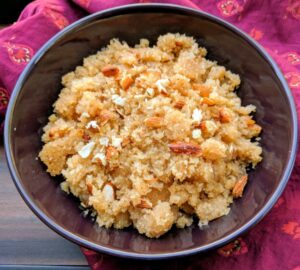Introduction

Sooji ka halwa, otherwise called semolina pudding, is a customary Indian pastry frequently made during celebrations, festivities, or basically to fulfill a sweet hankering.
It’s straightforward, fast, and requires only a couple of essential fixings. Whether you’re new to cooking or a specialist, this simple recipe will assist you with making a delightful bowl of sooji ka halwa in the blink of an eye!
Ingredients to make this recipe
– 1 cup Sooji (Semolina)
– 3/4 cup Ghee (Explained Margarine)
– 1 cup Sugar (conform to taste)
– 2 1/2 cups Water
– 1/4 cup Milk (discretionary for creamier surface)
– 8-10 Cashews
– 8-10 Almonds (cleaved or fragmented)
– 1/2 tsp Cardamom powder
– Raisins (discretionary, according to taste)
Step by step Guidelines:
1: Cook the Sooji
– In a weighty lined skillet, heat 1/2 cup of ghee.
– Add the sooji and cook it on a low fire until it becomes brilliant brown and deliveries a nutty fragrance. Mix ceaselessly to abstain from consuming.
– This step requires around 6-8 minutes.
2: Set up the Sugar Syrup
– While the sooji is cooking, in another pan, bring 2 1/2 cups of water and 1/4 cup milk to a bubble.
– Add sugar and mix until it’s completely broken down.
– Once finished, switch off the intensity and put away.
3: Blend Sooji in with Syrup
– Once the sooji is very much simmered, gradually pour the hot sugar syrup combination into the container while mixing persistently to stay away from bumps.
– Be careful, as the combination will splatter.
4: Add Flavor and Garnish
– Cook the blend on low intensity for around 5 minutes, mixing every so often until the sooji ingests all the fluid and thickens.
– Add the excess ghee, cardamom powder, and blend well.
– Decorate with hacked almonds, cashews, and raisins.
– Cook for another 2-3 minutes, then switch off the intensity.
5: Serve Hot
Your sooji ka halwa is fit to be served! Serve it hot, embellished with additional nuts whenever wanted.
Some Extra Tips:
1. Ghee is Key:
For the real kind of halwa, don’t hold back on ghee. It adds lavishness and improves the surface.
2. Roasting:
Simmering the sooji appropriately is significant for a decent surface and flavor. On the off chance that under-broiled, the halwa could taste crude.
3. Milk:
Adding milk is discretionary however gives the halwa a creamier surface.
Conclusion.
Sooji ka halwa is one of the least complex yet most encouraging treats you can make. Ideal for any event or similarly as a sweet treat after dinners, it’s a must-attempt recipe.
Whether it’s a celebration or a customary day, this halwa will without a doubt add pleasantness to your life!